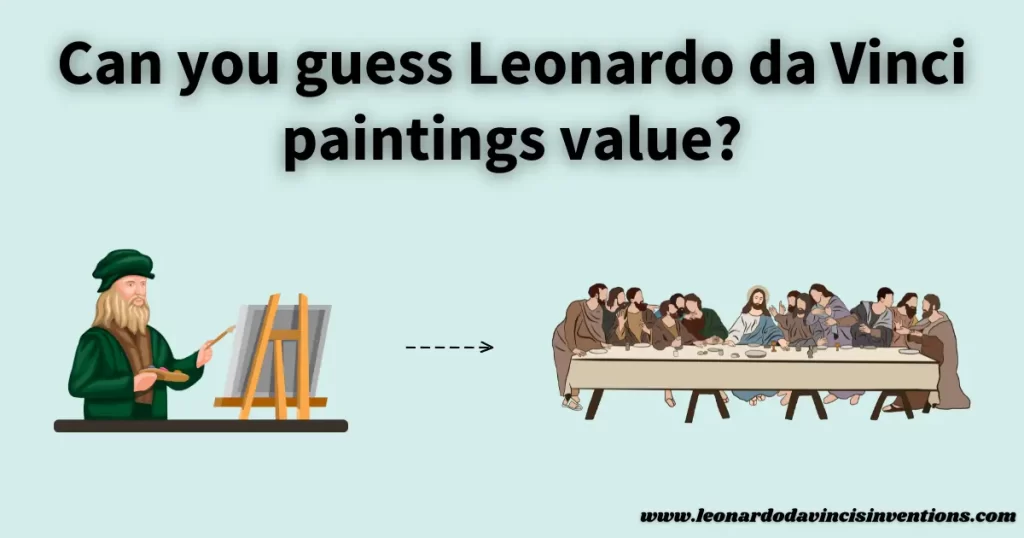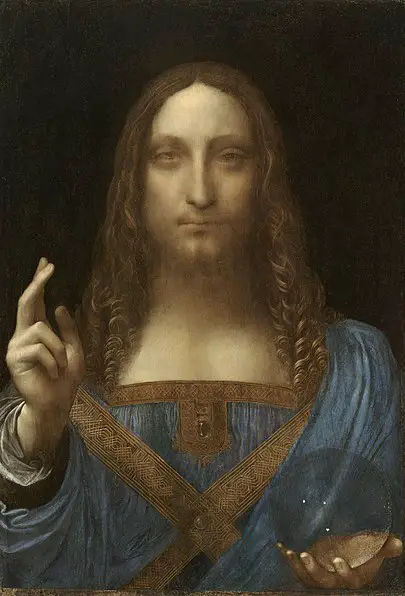
Leonardo da Vinci paintings value fascinates the art world, but knowing their true worth is challenging—many wonder if da Vinci work could appear for sale and what price it might bring.
According to auction records, Leonardo da Vinci’s Salvator Mundi sold for $450 million, making it the most expensive painting ever sold at auction.
Other da Vinci works, like the Mona Lisa, have insurance values that place them among the world’s most valuable paintings, though, as explained in this list, they will likely never be sold.
With so few confirmed paintings by da Vinci, each becomes even more prized. The rarity of his works adds to their incredible value.
Understanding Leonardo da Vinci Paintings Value in Today’s Art Market
Leonardo da Vinci’s paintings attract art collectors and investors worldwide. Their uniqueness and value are due to high auction prices, art market trends, and historical factors.
The Role of Provenance and Authenticity in the Value of Leonardo da Vinci Paintings
Provenance is the record of a painting’s ownership history. When the provenance is well documented, the artwork usually commands a high price because buyers trust its authenticity.
Experts verify Leonardo da Vinci’s paintings’ value by confirming the piece’s genuineness through research and scientific analysis. Authentication includes pigment analysis, X-ray imaging, and studying old records.
For works like Salvator Mundi, clear provenance and successful authentication led to a record-breaking sale of $450 million. Strong provenance and authenticity lower the risk of art forgery, which matters since so few of his paintings survive.
How Art Appraisal and Condition Affect the Value of Leonardo da Vinci Paintings
Art appraisal is when experts estimate an artwork’s value. For any Leonardo da Vinci painting, appraisal involves studying the work’s originality, condition, and historical significance.
Experts always evaluate the painting’s condition. Damages, restorations, and conservation efforts all influence its price.
Art conservation teams use advanced methods to stabilize masterpieces and prevent deterioration. A Leonardo piece in excellent condition with minimal restoration attracts higher offers during art sales.
Any damage or poor restoration can decrease its price, even if the work is authentic.
Market Trends and Art Market Fluctuations Influencing the Value of Leonardo da Vinci Paintings
The art market experiences periods of high demand and slower phases. When interest from art investors and collectors increases, Leonardo’s paintings often break market records.
Auction prices change with global economic conditions, art investment trends, and the availability of masterpieces. Competition among collectors pushes auction prices higher.
For example, when Salvator Mundi appeared at auction, it set a new bar for art market value. Leonardo’s paintings remain steady in value because of their rarity and importance in art history.
The Impact of Historical Significance and Cultural Heritage on the Value
Leonardo da Vinci paintings have immense historical significance as key examples of Renaissance art. Their impact goes beyond the art world and represents milestones in cultural heritage and artistic techniques.
Works like the Mona Lisa and The Last Supper have stories that have shaped art history. Because of their cultural value, museums and governments often try to keep such pieces in public collections.
Collectors pay more for paintings that changed people’s views of creativity and culture. The cultural heritage aspect can raise a Leonardo painting’s value above other famous artworks.
Art Dealers, Galleries, and Their Influence on the Value of Leonardo da Vinci Paintings
Art dealers and galleries help set art price estimates and guide buyers. They connect collectors to sellers and often manage important Leonardo pieces in private collections or arrange exhibitions to boost visibility.
Their expertise in appraisal and market transparency builds buyer confidence. Reputable galleries strengthen the artworks’ exhibition history, increasing their credibility and value.
Large auction houses like Christie’s and Sotheby’s work with dealers to organize high-profile art sales. Respected experts and influential dealers ensure any Leonardo da Vinci masterpiece reaches its potential in the current art market.
Record-Breaking Sales and Famous Masterpieces Shaping Leonardo da Vinci Paintings Value

Leonardo da Vinci’s paintings have climbed in value due to record-breaking sales, remarkable artistry, and increasing demand from public institutions and private collectors. Factors like rarity, provenance, and their place in art history affect how his works are appraised.
The Salvator Mundi Sale and Its Effect on Leonardo da Vinci Paintings’ Value
The auction of Salvator Mundi in 2017 set a new standard for the art market. This piece sold for over $450 million, making it the most expensive painting ever sold at auction.
The sale brought worldwide attention to da Vinci and raised expectations for the value of Renaissance art. Salvator Mundi’s authenticity, debated by experts, made headlines and increased interest in art authentication.
After this sale, the high price influenced price estimates for other Old Master works. It reinforced the importance of provenance and condition in art appraisal.
Why the Mona Lisa Remains a Benchmark for Painting Value and Art Investment
The Mona Lisa is Leonardo da Vinci’s most famous painting and a benchmark for the value of paintings and art investment. Held at the Louvre in Paris, it is not for sale, but experts often reference its priceless status when discussing the top end of the art market.
High art insurance values, public fascination, and its secure place in cultural heritage make the Mona Lisa an unmatched standard among famous artworks. Art collectors and institutions use their profile to help gauge the rarity and financial significance of other paintings.
The Mona Lisa shapes how the art world defines masterpiece status in terms of historical significance and fame.
The Last Supper’s Artistic Techniques and Its Value in the Art World
The Last Supper is a mural that was not bought or sold, but its impact on the value of Leonardo da Vinci’s paintings is significant. Da Vinci’s experimental techniques influenced generations of artists and made this work central to art history discussions.
The mural’s condition has presented challenges, but ongoing restoration has preserved its status as a key part of Renaissance art. Its fame boosts interest in da Vinci’s paintings and shows the importance of cultural heritage in art valuation.
Auction Prices and Art Auction Houses Setting New Records for Leonardo da Vinci Paintings
Auction houses such as Christie’s and Sotheby’s set the market value for Leonardo da Vinci’s works. The record-breaking sale of Salvator Mundi led to more media coverage and increased bidder competition.
Art sales involving da Vinci or works attributed to him often spark conversations about art market transparency and authenticity. High auction prices for Renaissance art drive up the value for other Old Masters.
These sales shape market speculation as investors see unique opportunities in rare, historically significant paintings.
Art Collectors and Private Collections Driving Demand for Leonardo da Vinci Paintings
Art collectors and private collections drive demand for da Vinci’s paintings and drawings. Their limited availability, strong provenance, and fame make acquiring their works a symbol of status and a smart investment.
Private sales are discreet but involve careful appraisal and legal protections against forgery. Collectors consult valuation experts to balance risks and ensure authenticity.
This demand affects public collections and the chances for art lovers to see these masterpieces in exhibitions or galleries worldwide.
Risks, Verification, and Future Outlook of Leonardo da Vinci Paintings Value
Leonardo da Vinci’s paintings’ value depends on several factors. Experts consider authenticity, condition, auction history, and market demand to estimate the prices these masterpieces can achieve.
Art Forgery, Art Authenticity Verification, and Their Impact on Paintings’ Value
Art forgery puts the value of Leonardo da Vinci’s paintings at risk. Forgeries sometimes fool even trained eyes, leading to mistrust among collectors and institutions.
Art authenticity verification keeps values high. Scientific analysis, expert review, and modern technology help check if a painting is a da Vinci work.
For example, the Salvator Mundi’s authentication involved years of technical tests and historical research. When doubts about authenticity arise, auction prices can drop, and a painting’s heritage status may be questioned.
Proven authenticity boosts confidence and supports record-breaking sales.
Understanding Art Investment Risks and Market Speculation Around Leonardo da Vinci Paintings
Art investment in Renaissance art, especially da Vinci masterpieces, comes with risks. Market trends shift as collectors’ interests, global economics, and cultural events influence prices for famous artworks.
Speculation sometimes drives prices to extremes, like the nearly half-billion-dollar sale of Salvator Mundi. Uncertainty about a painting’s history or legal status can cause price swings.
Art insurance helps collectors and galleries manage risk. Knowing about market fluctuations and records helps investors make informed decisions.
The Role of Art Restoration and Condition in Maintaining Paintings’ Value
The physical condition of a Leonardo da Vinci painting directly affects its market value. Damage from time, light, or improper storage lowers visual impact and sales price.
Art restoration can restore visual beauty and sometimes improve auction results. However, heavy restoration may also raise concerns about authenticity and artistic techniques.
Art experts assess which repairs respect the original work and which could hurt its value. Careful, documented restoration protects the painting’s resale potential and place in art history.
Art Appraisal Methods and Art Provenance Documentation for Accurate Value Estimates
Art appraisal methods combine expert inspection, scientific study, and historical research. Appraisers examine rarity, artistic quality, sales history, and documented exhibition records for Leonardo da Vinci paintings.
Provenance documentation is especially important. Verified ownership records from museums, art galleries, or private collections increase trust and accuracy in art valuation.
Strong provenance lowers the chance of buying a forgery and supports a stable price estimate.
How Art Market Transparency and Value Drivers Shape the Future of Leonardo da Vinci Paintings’ Value
Art market transparency is playing a growing role in the values of da Vinci’s masterpieces. Public records of auction prices, condition reports, and detailed provenance help buyers and sellers make better decisions.
High demand for rare works, the influence of art auction houses, and historical significance all act as key market value drivers. Art sales data from public institutions and private collections is expected to become even more detailed.
Frequently Asked Questions
Leonardo da Vinci’s paintings are some of the most expensive and famous in the world. Recent sales of his artwork have set records, and questions about owners, prices, and authenticity often come up.
Who bought the $450 million painting?
The painting “Salvator Mundi” by Leonardo da Vinci sold for $450.3 million at auction. Mohammed bin Salman, a representative of the Saudi Arabian Crown Prince, purchased it.
How do I know if the painting I have is valuable?
To determine if a painting is valuable, check for artist signatures, research the artwork’s history, and get an appraisal from a qualified expert. Sometimes owners think they have a da Vinci work, but expert advice is important.
What painting sold for $300 million?
“Interchange” by Willem de Kooning was one of the paintings sold for about $300 million. Leonardo da Vinci did not have a painting that sold for $300 million; his highest-known sale was much more.
Which Da Vinci painting sold for 400 million?
Leonardo da Vinci’s “Salvator Mundi” sold for over $400 million. It reached a final price of $450.3 million at auction, making it the most expensive da Vinci painting ever sold.
Who owns the male Mona Lisa?
The “male Mona Lisa” is a nickname sometimes used for “Salvator Mundi.” This painting is believed to be owned by the Saudi Arabian government or its representatives.
What is Leonardo’s most expensive painting?
Leonardo da Vinci’s most expensive painting is “Salvator Mundi.” It holds the record as the most expensive da Vinci painting ever sold.
How much was Mona Lisa sold for?
The “Mona Lisa” has never been sold. The French government holds and displays it at the Louvre Museum in Paris.
What is the most valuable painting in the world?
The “Mona Lisa” is often considered the most valuable painting in the world. Some estimates suggest its value could be over one billion dollars, but it is not on the market.
Who owns Mona Lisa?
The French government owns the “Mona Lisa.” It is kept in the Louvre Museum and is protected as a national treasure.
How much did the lost Leonardo sell for?
The “lost Leonardo,” known as “Salvator Mundi,” sold for $450.3 million at auction in 2017.
This price set a world record for art sales involving the value of Leonardo da Vinci paintings.




 Leonardo Bianchi,
the creator of Leonardo da Vinci's Inventions.
Thank you for visiting
Leonardo Bianchi,
the creator of Leonardo da Vinci's Inventions.
Thank you for visiting